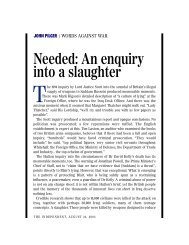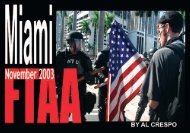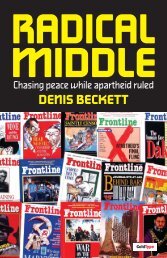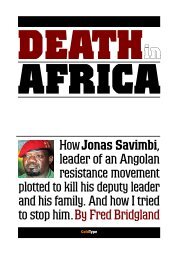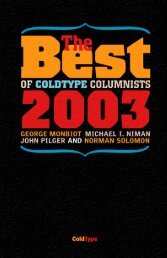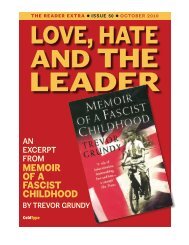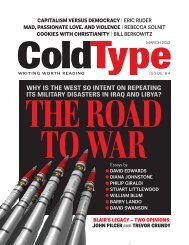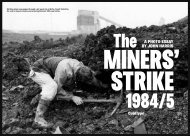UPDATED - ColdType
UPDATED - ColdType
UPDATED - ColdType
- TAGS
- updated
- coldtype
- coldtype.net
Create successful ePaper yourself
Turn your PDF publications into a flip-book with our unique Google optimized e-Paper software.
EMBEDDED: WEAPONS OF MASS DECEPTION<br />
tured on all three programs were Iraqi civilians,<br />
on BBC they comprised 17.1%. NBC Nightly News<br />
was the only news program in our analysis on<br />
which Iraqi civilians made up less than 10% of the<br />
featured protagonists, while the numbers were<br />
slightly higher on the other networks (ABC:<br />
13.7%, NBC: 9.6%, NBC: 12.1%).<br />
The American way of reporting I:<br />
unseen U.S. casualties<br />
ANOTHER category in which American news<br />
programs fell markedly behind in their coverage<br />
was the depiction of American casualties. After<br />
Al-Jazeera was sharply rebuked by U.S. officials<br />
for broadcasting images of dead and captured<br />
POWs, the depiction of U.S. casualties in particular<br />
seemed to become taboo on U.S. news programs.<br />
Short of saying that news producers and journalists<br />
were cowed into withholding information,<br />
Media Tenor’s data clearly shows a much greater<br />
reluctance on the part of U.S. news programs to<br />
show images of American dead and wounded<br />
than on foreign news programs, even though<br />
they had no problems depicting dead or<br />
wounded Iraqis – on NBC, the share of visual<br />
depictions on dead or wounded Iraqis even<br />
exceeded the share of verbal statements.<br />
Of all statements on dead, wounded or missing<br />
American soldiers on both ABC and NBC, 80.6%<br />
were delivered verbally, while only 19.4% were<br />
delivered in the form of visual depictions. On<br />
NBC, the share of visually depicted dead, missing<br />
or wounded was significantly higher, with<br />
42.4% of all statements on the subject.<br />
The coverage of Iraqi casualties offers one of<br />
the most obvious differences between coverage<br />
272<br />
in the U.S. and abroad, particularly if one considers<br />
that the number of American casualties was<br />
lower than in the Persian Gulf war, while the<br />
number of Iraqi casualties, both military and<br />
civilian, numbers in the thousands. In the U.S.,<br />
allied casualties comprised up to two thirds of all<br />
casualties reported on in evening news (ABC:<br />
58.9%, NBC: 60.5%, NBC: 67%). On BBC news programs,<br />
allied casualties made up 44.2% of casualties<br />
reported on; 50.6% were Iraqis. In Germany,<br />
the picture was almost the exact opposite from<br />
the U.S. On the low extreme, only 26.5% of casualties<br />
on ARD were allies, while 69.9% were<br />
Iraqis (ZDF: 35.9%/ 58.8%, RTL: 42.3%/ 55.1%).<br />
The American way of reporting II:<br />
CBS silences dissent<br />
IN their reports on U.S. society during the war,<br />
we found significant differences among U.S.<br />
news programs in the amount of coverage given<br />
to protests against the war. ABC World News<br />
Tonight reported most frequently on protests<br />
(101 statements), followed by NBC Nightly News<br />
(68 statements). With only 6 statements on<br />
protests in the U.S. in the time frame of our<br />
analysis, CBS Evening News hardly ever exposed<br />
its viewers to news of dissent among Americans.<br />
Only NBC featured a notable amount of coverage<br />
on both protests and political affairs in reference<br />
to societal protagonists in the U.S.<br />
With a geographical focus on non-allied countries,<br />
all three networks featured a comparable<br />
amount of coverage on these political aspects,<br />
but, once again, the disparity between the networks<br />
in their coverage of protests was glaring,<br />
with ABC taking the lead and NBC barely<br />
acknowledging protests abroad.



